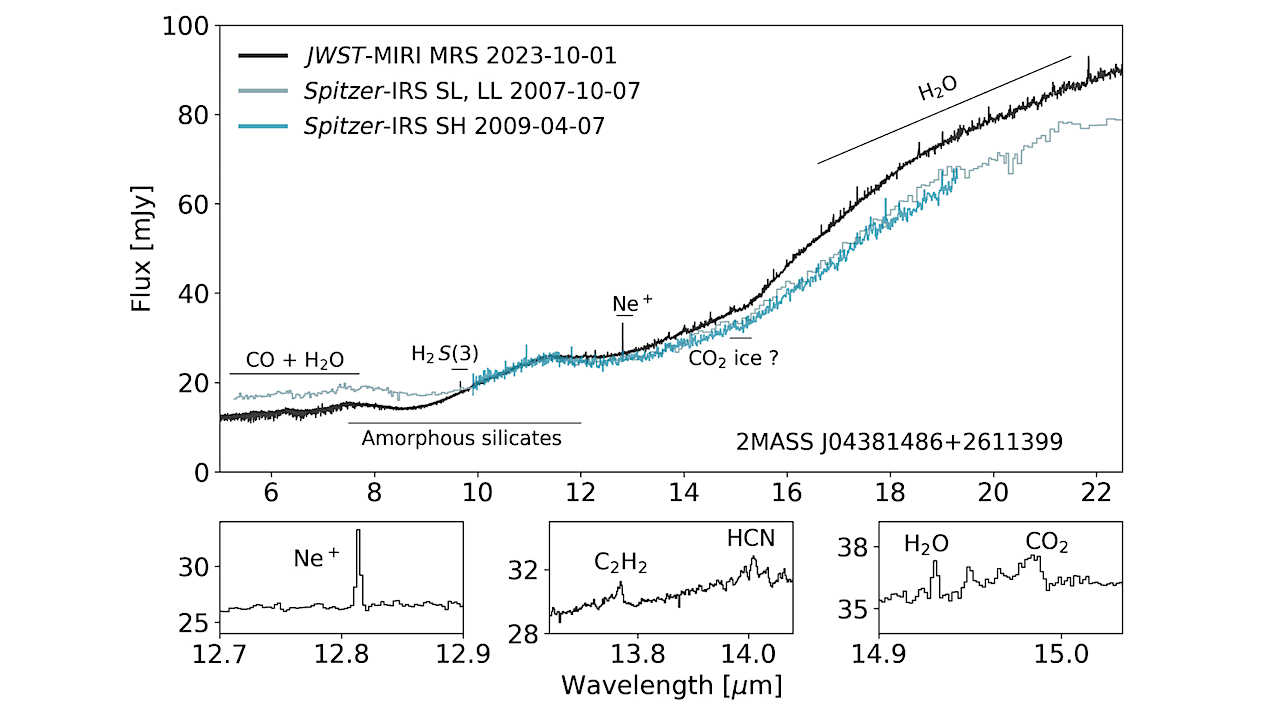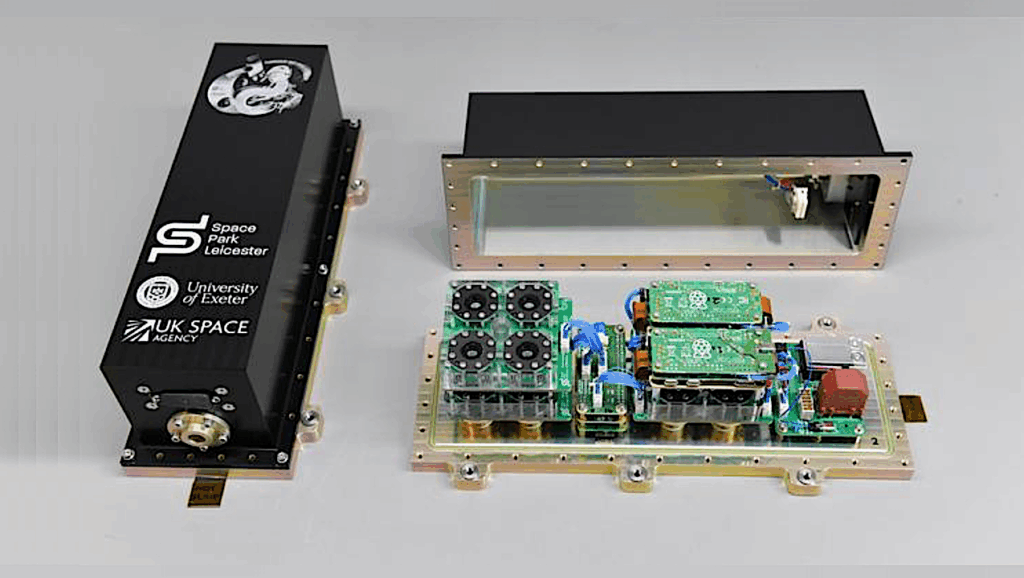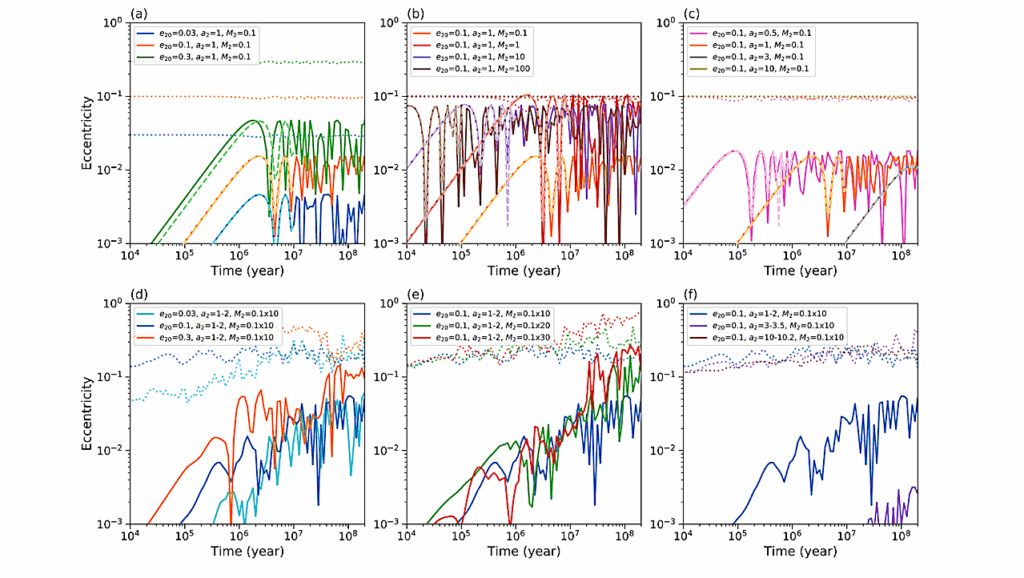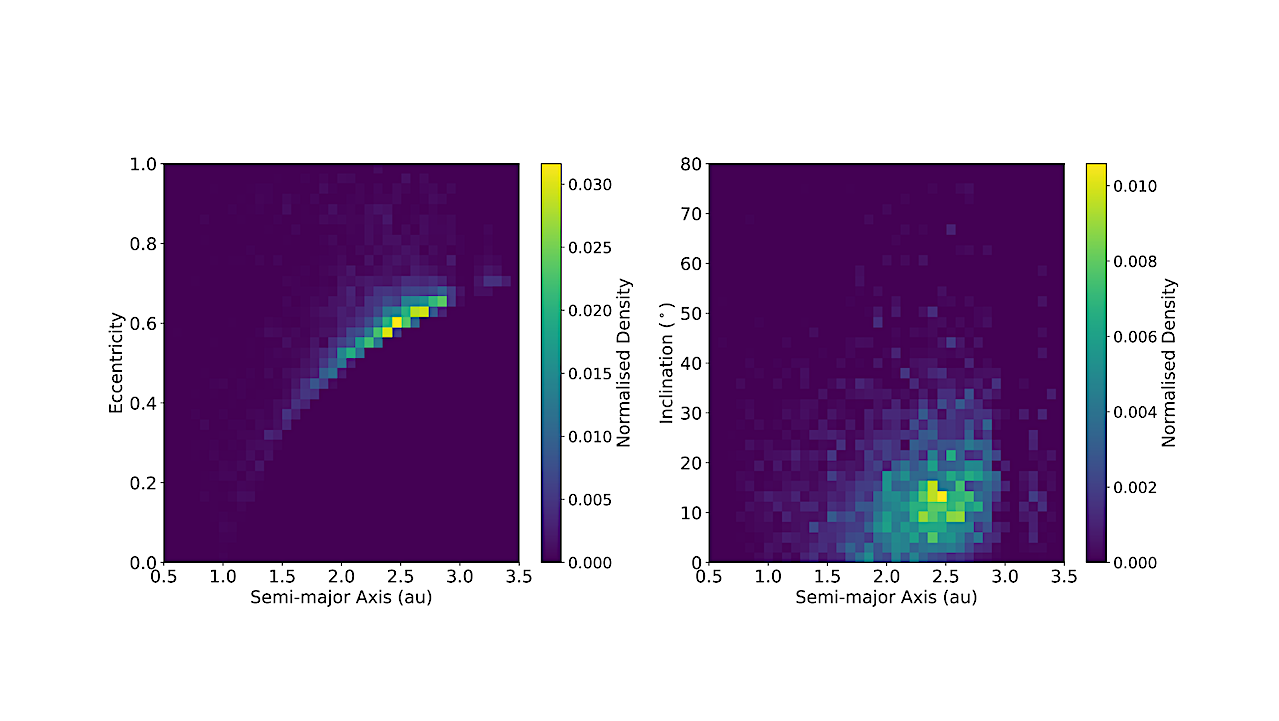Now Reading: MINDS. Anatomy Of A Water-rich, Inclined, Brown Dwarf Disk: Lack Of Abundant Hydrocarbons
-
01
MINDS. Anatomy Of A Water-rich, Inclined, Brown Dwarf Disk: Lack Of Abundant Hydrocarbons
MINDS. Anatomy Of A Water-rich, Inclined, Brown Dwarf Disk: Lack Of Abundant Hydrocarbons


JWST-MIRI MRS spectrum of the young J0438 disk (black). The spectrum is dominated by amorphous silicate absorption and emission bands typical of a highly inclined disk configuration. A very weak CO2 ice absorption feature is tentatively detected (see Appendix A, Fig. 8) along with inner disk gas reservoir (Table 3) composed by molecular hydrogen (H2), water (H2O), carbon dioxide (CO2), hydrogen cyanide (HCN), acetylene (C2H2) and the singly ionized cations of argon and neon ([Ar+], [Ne+]; for zoom-ins see Appendices B and C). The comparison between the JWST-MIRI and the Spitzer -IRS low- (SL, LL) and high- (SH) resolution spectra reveal continuum and line variability (grey and teal). The Spitzer -IRS spectra were taken from CASSIS (Lebouteiller et al. 2011, 2015) and Pascucci et al. (2013). — astro-ph.EP
2MASS J04381486+2611399 (or J0438) is one of the few young brown dwarfs (BD) with a highly inclined (i∼70∘) disk.
Here we report results from JWST-MIRI MRS, HST-ACS and ALMA Band 7 observations. Despite its late spectral type (M7.25), the spectrum of J0438 resembles those of inner disks around earlier-type stars (K1-M5, T Tauri stars), with a volatile reservoir lacking hydrocarbons (except for acetylene, C2H2) and dominated by water. Other identified species are H2, CO2, HCN, [Ar+], and [Ne+].
The dominance of water over hydrocarbons is driven by multiple factors such as disk dynamics, young disk age, low accretion rate and possible inner disk clearing. J0438 appears highly dynamic, showing a seesaw-like variability and extended emission in H2S(1), S(3), S(5), [Ne+] and CO (J=3−2).
Interestingly, the CO emission reaches up to 400 au from the brown dwarf, suggesting ongoing infalling/outflowing activity impacting the disk chemistry. These observations underscore the combined power of JWST, HST and ALMA in characterizing the chemical diversity and dynamics of brown dwarf disks.

Schematic illustration of the inner disk around the young brown dwarf J0438. The inner disk of J0438 is characterized by faint water vapour and not by hydrocarbon-rich gas despite of the late spectral type (M7.25). The possible presence of an inner hole at ∼ 0.28 au reported by Luhman et al. (2007) and the low mass accretion rate (∼ 10−11M⊙ yr−1 ; Muzerolle et al. 2005) are likely responsible for slowing down the inward drift of icy dust grains/pebbles and hence for prolonging a water-rich phase for this disk. ALMA observations resolved extended emission from the BD disk suggesting ongoing outflowing/infalling activity. Image credit: A. Houge. — astro-ph.EP
Giulia Perotti (1 and 2), Nicolás T. Kurtovic (3), Thomas Henning (1), Göran Olofsson (4), Aditya M. Arabhavi (5), Kamber Schwarz (1), Jayatee Kanwar (5 and 6 and 7), Roy van Boekel (1), Inga Kamp (5), Ilaria Pascucci (8), Ewine F. van Dishoeck (9 and 3), Manuel Güdel (10 and 11), Pierre-Olivier Lagage (12), David Barrado (13), Alessio Caratti o Garatti (14 and 15), Adrian M. Glauser (11), F. Lahuis (16), Valentin Christiaens (17 and 18), Riccardo Franceschi (19), Danny Gasman (17), Sierra L. Grant (3), Hyerin Jang (20), Till Kaeufer (21), Maria Morales-Calderón (13), Milou Temmink (9), Marissa Vlasblom (9) ((1) Max-Planck-Institut für Astronomie, Heidelberg, Germany, (2) Niels Bohr Institute, University of Copenhagen, Copenhagen, Denmark, (3) Max-Planck Institut für Extraterrestrische Physik (MPE), Garching, Germany, (4) Department of Astronomy, Stockholm University, AlbaNova University Center, Stockholm, Sweden, (5) Kapteyn Astronomical Institute, Rijksuniversiteit Groningen, Groningen, The Netherlands, (6) Space Research Institute, Austrian Academy of Sciences, Graz, Austria, (7) TU Graz, Fakultät für Mathematik, Physik und Geodäsie, Graz, Austria, (8) Lunar and Planetary Laboratory, The University of Arizona, Tucson, USA, (9) Leiden Observatory, Leiden University, Leiden, the Netherlands, (10) Dept. of Astrophysics, University of Vienna, Vienna, Austria, (11) ETH Zürich, Institute for Particle Physics and Astrophysics, Zürich, Switzerland, (12) Université Paris-Saclay, Université Paris Cité, CEA, CNRS, AIM, Gif-sur-Yvette, France, (13) Centro de Astrobiología, CSIC-INTA, Madrid, Spain, (14) INAF – Osservatorio Astronomico di Capodimonte, Napoli, Italy, (15) Dublin Institute for Advanced Studies, Dublin, Ireland, (16) SRON Netherlands Institute for Space Research, Groningen, The Netherlands, (17) Institute of Astronomy, KU Leuven, Leuven, Belgium, (18) STAR Institute, Université de Liége, Liége, Belgium, (19) LESIA, Observatoire de Paris, Université PSL, CNRS, Sorbonne Université, Université de Paris, Meudon, France, (20) Department of Astrophysics, IMAPP, Radboud University, Nijmegen, The Netherlands, (21) Department of Physics and Astronomy, University of Exeter, Exeter, UK)
Comments: 30 pages, 18 figures, resubmitted the first revision to ApJ
Subjects: Earth and Planetary Astrophysics (astro-ph.EP); Astrophysics of Galaxies (astro-ph.GA); Solar and Stellar Astrophysics (astro-ph.SR)
Cite as: arXiv:2504.11424 [astro-ph.EP] (or arXiv:2504.11424v1 [astro-ph.EP] for this version)
https://doi.org/10.48550/arXiv.2504.11424
Focus to learn more
Submission history
From: Aditya Mahadeva Arabhavi
[v1] Tue, 15 Apr 2025 17:37:59 UTC (5,759 KB)
https://arxiv.org/abs/2504.11424
Astrobiology,
Stay Informed With the Latest & Most Important News
-
 012024 in Review: Highlights from NASA in Silicon Valley
012024 in Review: Highlights from NASA in Silicon Valley -
 02Panasonic Leica Summilux DG 15mm f/1.7 ASPH review
02Panasonic Leica Summilux DG 15mm f/1.7 ASPH review -
 03How New NASA, India Earth Satellite NISAR Will See Earth
03How New NASA, India Earth Satellite NISAR Will See Earth -
 04And Thus Begins A New Year For Life On Earth
04And Thus Begins A New Year For Life On Earth -
 05Astronomy Activation Ambassadors: A New Era
05Astronomy Activation Ambassadors: A New Era -
06SpaceX launch surge helps set new global launch record in 2024
-
 07Space Force plans new ‘Futures Command’ amid pressure to speed up modernization
07Space Force plans new ‘Futures Command’ amid pressure to speed up modernization




















